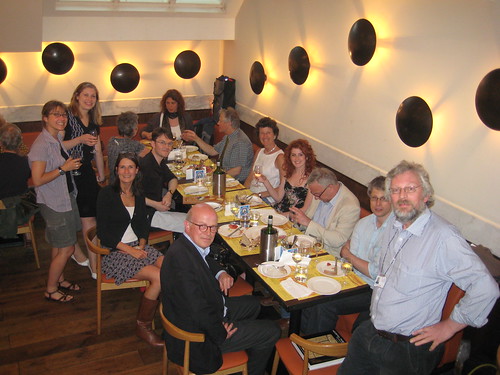You may be wondering why this post is accompanied by a photo of a party. Where is the art, you say? What does this have to do with the Medieval and Renaissance periods? Have I stumbled on someone’s Facebook page?
Well, I thought you might like to see one of the less obvious results of our work preparing for the new Medieval & Renaissance Galleries. While the galleries were being designed and built, there was a huge amount of research going on behind the scenes to re-assess some of our greatest treasures. One of the curators carrying out research was Dr Paul Williamson, the head of the Sculpture, Metalwork, Ceramics and Glass department, who is one of the world experts on medieval ivory carving. Paul spent a year researching and writing a new catalogue of our early medieval ivories – one of the most important parts of our earlier collections. We weren’t able to publish it in time for the opening of the new galleries in November, but the advance copies have now arrived, and the book will be going on sale to the public soon. Paul, by the way, is the man with the glasses and dark jacket sitting towards the front.
I’m often asked why we didn’t issue a catalogue to accompany the new Medieval & Renaissance Galleries. The answer to this is simple – we issue catalogues to accompany temporary exhibitions, but not permanent displays. The permanent collections are catalogued according to media type, and we have been issuing catalogues of different areas of the collection every few years for a long time now!
Paul’s new book is the first of a series of three which will completely catalogue all the V&A’s ivories, a collection of about 500 objects. Ivory may today seem an odd sort of material to be a major art form during the middle ages, but it enjoyed periods of real popularity during the period. It’s hard to know why exactly this was, but it is noticeable that most of the luxury arts of the medieval period used raw materials that were exotic and hard to obtain – think of silk, gold and silver, or the lapis lazuli pigment used for the finest blue details in paintings. The whiteness of ivory, its durability, and the very tactile nature of ivory carvings (you have to really restrain yourself from touching them) were all probably part of its appeal.
The picture shows a little reception that Paul held to celebrate the completion of the book. I say ‘little’, but even with a single-author book like this, you can see that a large number of people ended up contributing to it! In the photo are staff from the V&A Conservation studios, who carried out scientific examination and testing on the objects; staff from the Photo Studio, who took the wonderful photographs that fill the book; experts from other parts of the Museum, like Rowan Watson, the curator responsible for our medieval manuscripts; the editors and staff of V&A Publications; and many more. Paul is having a more official launch party this week – but it was lovely for all those closely involved in the project to come together to mark its completion.
But of course, it’s never complete. No catalogue is truly the last word on the subject. And now Paul and I have started work on Volume II, which will take up where this catalogue leaves off, and go from 1200 to 1550, covering another 300-odd objects. Volume III is also in the process of being written, by Marjorie Trusted. This kind of scholarship on the collection may not be of any obvious significance for many of our visitors. But in reality, it decisively shapes the ways in which the objects are presented and discussed within the galleries. Many people who would never read Paul’s academic catalogue will certainly see our objects differently because of his research. For instance, one of our greatest treasures, the ivory crozier telling the story of Saint Nicholas, has always been described as English (have a look at it on http://collections.vam.ac.uk/item/O70467/staff-head-the-st-nicholas-crozier/). Paul convincingly demonstrates that it is French, and this will transform the ways in which it is presented in the future.
